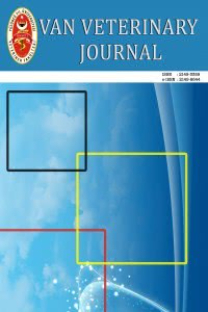Comparative studies on effect of S(+)-Ketamine-Medetomidine and racemic Ketamine- Medetomidine in Mouse
anestetikler, fareler, ketamin, karşılaştırmalar, ağrı kesiciler, medetomidin
Farelerde S(+)-Ketamin-Medetomidin ve Ketamin Razemat-Medetomidin 'in etkilerinin karşılaştırılması
anaesthetics, mice, ketamine, comparisons, analgesics, medetomidine,
___
1.Erhardt W, Wohlrab S, Kılıç N, Henke J (2001): Comparison of the anaesthesia combinations racemic-ketamine/medetomidine and S-Ketaminemedetomidine in Syrian golden hamsters (mesocricetus auratus). J. Vet. Anaest. 28 (4): 212-213.2.Flecknell PA (1997): Laboratory animal anaesthesia. (2nd Ed.). Academic Press, London.
3.Kılıç N, Henke J, Pragst I, Echardt W (2001): Comparison of three different medetomidin/ketamin combinations in NMRI mice. J. Vet. Anaest. 28 (4): 211-212.
4.Macdonald E, Scheinin M, Scheinin H (1988): Behavioural and neurochemical effects of medetomidine, a novel veterinary sedative. Eur. J. Pharmacol. 158: 119-127.
5.Morris TH (1991): Use of medetomidine and atipemazole in laboratory animals. Proceedings of the 4th Internatinal Congress of Veterinary Anaesthesia, Utrecht, Special supplement of the J. Vet. Anaesth. 277-279.
6.Nevalainen T, Pyhala L, Voipio HM, Virtanen R (1989): Evaluation of anaesthetic potency of medetomidine-ketamine combination in rats, guinea-pigs and rabbits. Acta Vet. Scandinavica. 85: 139-143.
7.Pfenninger E, Baier C, Claus S (1992): Analgesia and psychic side-effects under ketamine racemate versus S-(+)-ketamine in analgesic doses. Anesthesiology. 77: 413-415.
8.Savola JM (1989): Cardiovascular actions of medetomidine and their reversal by atipemazole. Acta. Vet. Scand. 85: 39-47.
9.Stelter A (2001): Die Anästhesie bei der Katze mit Medetomidin und Ketamin bzw. S-Ketamin - eine klinische Studie.Vet. Medical. Diss., München.
10.Tunkel F (2001): Die Anästhesie beim Hund mit Ketamin-Razemat/Medetomidin im Vergleich zu S-(+)-Ketamin/Medetomidin; Eine klinische Studie. Vet. Medical. Diss., München.
11.Vaehe-Vaehe T (1989): Clinical evaluation of medetomidine, a novel sedative and analgesic drug for dogs and cats. Acta Vet Scand. 30: 267-273.
12.Vainio O (1989): Introduction to the clinical pharmacology of medetomidine. Act. Vet. Scan. Supp. 85: 85-88.
13.Virtanen J, Savola JM, Saano V, Nyman L (1988): Characterization of the selectivity, specifity and potency of medetomidine as an a2-adrenoceptor agonist. Act. Vet. Scand. 85: 29-37.
14.Voipio HM, Nevalainen TO, Virtanen R (1990): Evaluation of anesthetic potency of medetomidine-ketamine combination in mice. IX ICLAS Symposium Proceedings. pp. 298-299.
15.Wijngergen A (1995): Krankheiten der Heimtiere, 3.Auflage, Schlütersche, Hannover.
16.Wixson S (1994): Anaesthesia and analgesia. In, Smith AC, Swindle MM (Eds): Rabbits and Rodents. The Scientists Center for Animal Welfare, Williams & Wilkins, Baltimore, 59-75.
- ISSN: 1017-8422
- Yayın Aralığı: 3
- Başlangıç: 1990
- Yayıncı: Yüzüncü Yıl Üniv. Veteriner Fak.
HAKKI AKDENİZ, MEHMET AKİF KARSLI, BİLAL KESKİN, Nuray ANDİÇ
İneklerdeki üçgen hastalığında bazı biyokimyasal parametreler
TEKİN ŞAHİN, İLKER ÇAMKERTEN, Yaralıoğlu Sema GÜRGÖZE
Nurcan DÖNMEZ, MEHMET AKİF KARSLI
Milk yield characteristics of Norduz sheep
ORHAN YILMAZ, HÜSEYİN DENK, HÜSEYİN NURSOY
Efficacy of tissupor wound pad on wound healing in rabbits
Halil SELÇUKBİRİCİK, Nihat ŞINDAK, Ali HAYAT, Hacı ERASLAN, Süleyman GANİDAĞLI, Güler TURSUN
Van yöresinde bazı süt sığırcılığı işletmelerinde rotavirus enfeksiyonunun serolojik araştırılması
Neonatal ishali buzağılarda hamatolojik, biyokimyasal ve elektrokardiyografik bulgular
Rottweiler ırkı bir köpekte ekzama olgusu
TEKİN ŞAHİN, NİHAT ŞINDAK, Sema GÜRGÖZE YARALIOĞLU, İLKER ÇAMKERTEN
